Amazing Stories, August 1967: A Retro-Review
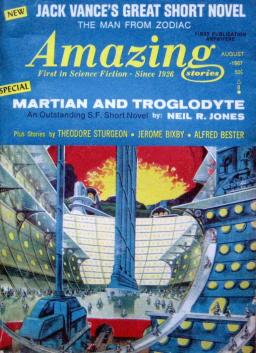 I have recently covered a lot of issues of Amazing (and Fantastic) from the Cele Goldsmith/Lalli era, which extended (officially) from December 1958 through June 1965. The two magazines were then sold to Ultimate Publishing, owned by Sol Cohen. Cohen (and managing editor Joseph Ross) immediately instituted a policy of publishing mostly reprints of stories previously published in Amazing/Fantastic, which lasted until Ted White took over in 1969. (White’s issues still featured reprints for a while, but by the time I was buying the magazine (in 1974) the cover would proclaim “All Stories New – No Reprints.”)
I have recently covered a lot of issues of Amazing (and Fantastic) from the Cele Goldsmith/Lalli era, which extended (officially) from December 1958 through June 1965. The two magazines were then sold to Ultimate Publishing, owned by Sol Cohen. Cohen (and managing editor Joseph Ross) immediately instituted a policy of publishing mostly reprints of stories previously published in Amazing/Fantastic, which lasted until Ted White took over in 1969. (White’s issues still featured reprints for a while, but by the time I was buying the magazine (in 1974) the cover would proclaim “All Stories New – No Reprints.”)
Joseph Ross (and Cohen) were briefly succeeded as editor by Harry Harrison and then by Barry Malzberg, both of whom (as I understand) resisted Cohen’s reprint policy. To make things worse, Cohen refused to pay the authors for reprinted stories (technically legal under the terms Amazing had originally bought the stories under). The then new organization SFWA took exception, and threatened a boycott, after which, I believe, Cohen agree to pay at least a nominal fee.
After Amazing and Fantastic stopped publishing reprints (and even before), Ultimate published a variety of dreadful magazines with different titles like Great Science Fiction Stories, and Thrilling Science Fiction, that were all reprint. (Again, all from inventory owned by Ultimate.)
I remember buying one early in my reading career – I thought I had found a brand new SF magazine, and was crushed to realize it was all mostly shoddy reprints. (There was a decent John Campbell story, probably “Uncertainty,” which appeared in the July 1974 Science Fiction Adventure Classics.)
Anyway, I happened to buy one of the Cohen/Ross era Amazings, mainly because it has a rather obscure Jack Vance story that I had not read. And I figured it would be interesting to compare it to Lalli’s Amazing. What is interesting is that, viewed objectively and ignoring the fact that most of the stories are reprints, this is quite a good issue, with at least one very fine story that has been largely forgotten.
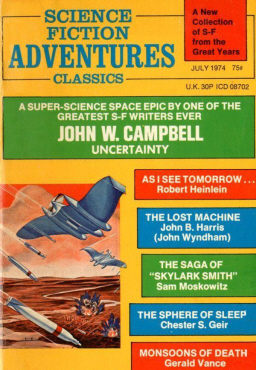
The reprint policy seems to have extended to the covers: this one is by Frank Paul. It’s pretty good, I think. Don’t know where it first appeared. There are two features: The Future in Books, a review column by Harry Harrison; and a fairly dire poem by Miles Breuer, “Vis Scientiae,” that first appeared in the May 1930 issue.
Harrison’s column gushes over Brian Aldiss’ collection Who Can Replace a Man?, without discussing any of the stories. Harrison claims that’s the right way to review a collection… I beg to disagree. (“You would not take up a collection of Kipling and go through it saying ‘I like this one, I don’t like this’” – Really? You couldn’t review A Diversity of Creatures and notice that “Mary Postgate” is maybe a bit more interesting than, say, “The Honours of War”?) I suspect that Harrison’s close friendship with Aldiss may have left him feeling that praise was necessary (and, to be sure, very much deserved) but that too close a look would be uncomfortable.
He also reviews collections of Laumer and Brunner, not quite so gushingly but still positively (and, I note, at least for the Brunner, saying, more or less, ‘I like this one, I don’t like that one’), mentions a collection of novellas by Leinster, Williamson and Wyndham with some rather left-handed compliments (“fine bits of nostalgia”) and with a rebuke for the Sam Moskowitz introduction (“ancient factual data and ancient opinion are mixed in equal portions”); and he has very high praise for The Einstein Intersection.
The magazine’s production values are a bit off, probably because some (or possibly all) of the reprinted stories were produced by photographing copies of the original magazine pages.
The stories are:
“The Man From Zodiac” by Jack Vance (18,000 words) (original)
“Martian and Trogolodyte” by Neil R. Jones (15,000 words) (first published in Amazing, May 1933)
“Blabbermouth” by Theodore Sturgeon (8,500 words) (first published in Amazing, February 1947)
“One Way Street” by Jerome Bixby (6,500 words) (first published in Amazing, December 1953 – January 1954)
“North God’s Temple” by Henry J. Kostkos (5,500 words) (first published in Amazing, August 1934)
“The Roller Coaster” by Alfred Bester (2,500 words) (first published in Amazing, May 1953)
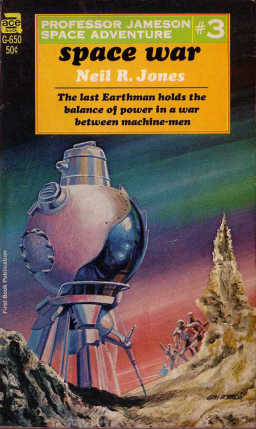 Two of the stories are from the 1930s, and they are almost caricatures of how bad ’30s SF could be.
Two of the stories are from the 1930s, and they are almost caricatures of how bad ’30s SF could be.
“Martian and Troglodyte” is set 200,000 years ago, about when modern humans appeared. Thrag is a caveman who has been banished from his tribe due to the duplicity of the new chief, who lusts after Thrag’s wife. On his own, he is menaced by a cave bear, and, about to be killed, he is saved by a couple of visiting Martians. Soon he in turn saves the Martians, and they give him a laser gun, which he uses to return to his tribe and try to rescue his wife… alas, the gun breaks, and the Martians soon have to save the day again.
In its bald outlines, there’s a potentially decent story here, but it’s ruined mainly by the dreadful prose. Neil R. Jones was once somewhat famous for his Professor Jameson stories – I haven’t read any of those, were they this bad?
Henry J. Kostkos (1900-1977) published a dozen stories in the field between 1934 and 1940. Most appeared in Amazing (a couple were in Astounding, and one each in Wonder and Science Fiction). The only places any of his stories have ever been reprinted (according to the ISFDB) are the Ultimate Publishing reprint ‘zines (including Amazing itself). Based on “North God’s Temple,” that’s on merit (or lack thereof).
In this story a scientist detects a mental signal that he realizes comes from a race of creatures that live under the arctic ice, and worship a Magnetic God. These creatures are the last descendants of the intelligent inhabitants of the planet that formed the asteroid belt when it exploded. They came to Earth on a highly magnetic fragment of their planet, which crashed near the North Pole and gave the Earth its magnetic field. Anyway, the scientist organizes an expedition to the Pole, and ends up traveling in a metal ship pulled by magnetism to the temple… Really really bad stuff.
So… not so good so far. But the rest of the issue is all worth reading.
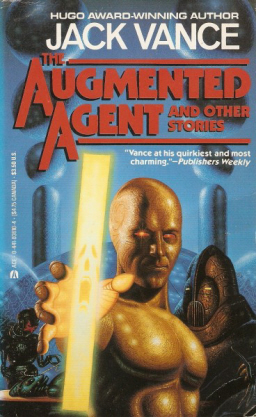 First the longest piece, the Jack Vance story. “The Man from Zodiac” is not at all well-known. It was only reprinted (in English) in The Augmented Agent and Other Stories, one of the limited edition Underwood-Miller collections of the 80s, though there was also an Ace paperback edition. And it also appeared in the Vance Integral Edition, under his preferred title, “Milton Hack from Zodiac.” It has just recently been reprinted in the very worthy Subterranean Press series The Early Jack Vance in Volume IV, Minding the Stars. I had not previously seen it.
First the longest piece, the Jack Vance story. “The Man from Zodiac” is not at all well-known. It was only reprinted (in English) in The Augmented Agent and Other Stories, one of the limited edition Underwood-Miller collections of the 80s, though there was also an Ace paperback edition. And it also appeared in the Vance Integral Edition, under his preferred title, “Milton Hack from Zodiac.” It has just recently been reprinted in the very worthy Subterranean Press series The Early Jack Vance in Volume IV, Minding the Stars. I had not previously seen it.
It’s middling (or slightly less than middling) Vance, kind of in the mode of his Miro Hertzel stories (“The Dogtown Tourist Agency” and “Frietzke’s Turn”), which appeared a few years later. Even less than middling Vance is still quite enjoyable, though.
Milton Hack is a functionary for Zodiac Control, a company which provides administrative services to political entities on other planets. Hack is caught up in a dispute between the two heirs of the founder after the founder dies, and ends up having to deal with the foolish decision of one of them to sign a poorly written contract with a violent group, the Phrones, on another planet. The Phrones just want help exterminating their neighbors, the Sabols. Hack just wants to give them a decent sewer system… Then the Sabol contract falls into his lap as well, and he comes up with an idea. It’s really not terribly convincing, but it is amusing, and the droll and dry writing is a pleasure.
I will note that the blurb for the story claimed that both “The Man from Zodiac” and “The Narrow Land,” published in Fantastic at the same time, were the beginnings of series… but no further stories in either “series” were published. (It should be noted that each story certainly could have spawned a series.)
Sturgeon’s “Blabbermouth” is, like the Vance story, an example of its writer’s work at rather less than his best, but still interesting. Though it was first published in 1947, Paul Williams found an early draft dating to 1941. He thinks it was finished shortly thereafter, rejected, and then finally sold after the war.
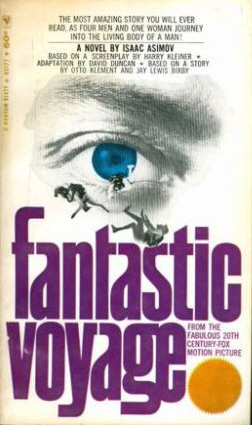 I am not convinced: I think Sturgeon quite likely reworked the earlier draft (changing the sex of the title character, for one obvious thing) when he returned to active writing after the war. (For some reason the ISFDB dates the story 1945, but shows no publication before 1947.)
I am not convinced: I think Sturgeon quite likely reworked the earlier draft (changing the sex of the title character, for one obvious thing) when he returned to active writing after the war. (For some reason the ISFDB dates the story 1945, but shows no publication before 1947.)
The story is told by a modestly successful disc jockey, Eddie, who runs across a girl, Maria, he knew in high school, and admired then. He tries to rekindle their relationship, successfully, and soon they’re married, despite a troubling episode where Maria tells a perfect stranger that her husband is cheating on her, and despite Maria’s subsequent refusal to go out in public with Eddie. But Eddie’s job requires him to entertain and be entertained, and eventually he insists she go out with him, with disastrous results (she tells tales on almost everyone she meets). She explains that she’s susceptible to what she calls a “poltergeist,” formed when one person’s suspicion meets another’s guilt – this possesses Maria, and she is compelled to reveal what she knows.
That’s an interesting, and Sturgeonesque, idea, but Sturgeon’s working out — as Maria’s gift (or curse) leads to a crisis in Eddie’s professional life, which is eventually solved when he comes up with a (slightly illogical) workaround — is more at the slick and slangy level than later Sturgeon, which would have made something powerful of it.
The prize story this issue is from Jerome Bixby, remembered nowadays almost entirely for his SF Hall of Fame story “It’s a Good Life” (also one of the classic Twilight Zone episodes). Bixby was also editor of Planet Stories for about a year, and a prolific writer in many genres. He wrote several Star Trek episodes and the original story for the movie Fantastic Voyage.
“One Way Street” concerns Pete, a man who has a car accident, and after waking up in the hospital slowly realizes that he’s not quite in his world. Personal details are slightly different – his neighbor’s name, his dog – and details of the wider world are different: telephones, for example. He is regarded as having been driven slightly mad by the trauma of the accident, and eventually accepts his new world, partly reconciled by the fact that he loves his “new” wife, who is the same woman is his original wife but somehow just different enough; and she too loves him more (it seems) than “her” Pete.
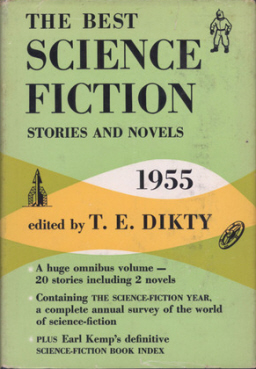 But eventually the scientists who accidentally caused him to switch worlds figure it out, and they convince him that he must return to his world, as his presence is potentially destabilizing. This leads to a well-executed twist. The story reminded me of two great alternate world stories that were nominated for the Hugo in the same year (one winning): Lawrence Watt-Evans’ “Why I Left Harry’s All-Night Hamburgers,” and Michael Flynn’s “The Forest of Time.”
But eventually the scientists who accidentally caused him to switch worlds figure it out, and they convince him that he must return to his world, as his presence is potentially destabilizing. This leads to a well-executed twist. The story reminded me of two great alternate world stories that were nominated for the Hugo in the same year (one winning): Lawrence Watt-Evans’ “Why I Left Harry’s All-Night Hamburgers,” and Michael Flynn’s “The Forest of Time.”
I thought it very good. It was well-received at first, being chosen for The Best Science Fiction Stories and Novels: 1955, edited by T. E. Dikty, but since then it’s only appeared in a Bixby collection and in a 1987 Signet anthology of alternate world stories, from Robert Adams, Pamela Crippen Adams, and Martin H. Greenberg.
Finally, “The Roller Coaster” is a solid Alfred Bester work from his vigorous 1950s period. It reminded me of Kuttner and Moore’s “Vintage Season,” John Kessel’s “The Pure Product,” with perhaps a taste of Leiber’s “Coming Attraction.” The main character is trying to goad a woman into a violent reaction to his abuse, but she disappoints him. He tries to find his friend Freyda, but the man she was involved with is trying to commit suicide, and she’s gone… She suggests another woman for his attentions, and he finds the woman’s husband, and hears the story of his problems…
The solution (easily guessed especially with the hints I’ve given) is a bit pat, so it’s not a great Bester story, but it’s effective enough.
Rich Horton’s last retro-review for us was the September 1959 issue of Fantastic Universe. See all of Rich’s retro-reviews here.
The only Jones stories I’ve read are the Professor Jameson ones, and the prose is pretty bad. (In Before the Golden Age, Asimov said that the Jones story reprinted there had the worst prose in the book.) I find the Jameson stories lively enough to be readable, but I know that many people wouldn’t. I do think the quality of his writing got (a little) better as time went on.
Once again a retro-review of one of these old magazines is one of my favorite features of Black Gate. I appreciate these pieces.
I’ve just stumbled across Black Gate (courtesy of io0) and am delighted with the treasures here. I especially love the reviews of these old stories.
Welcome, Redjellydonut! Any friend of vintage short fiction is a friend of ours.
[…] Horton’s last retro-review for us was the August 1967 issue of Amazing Stories. See all of Rich’s […]